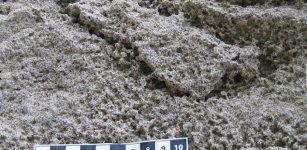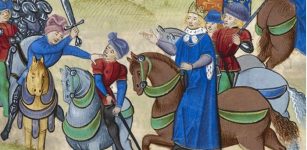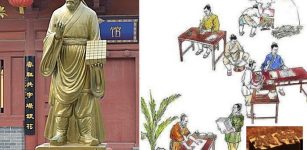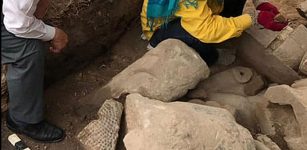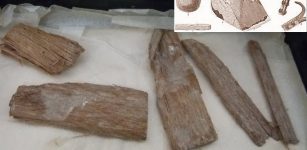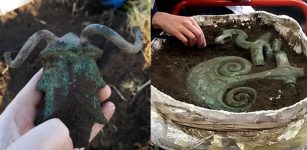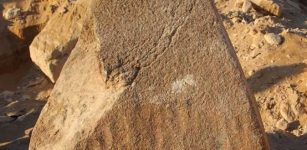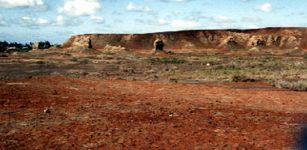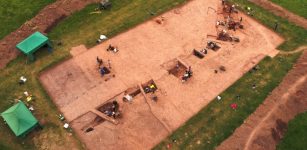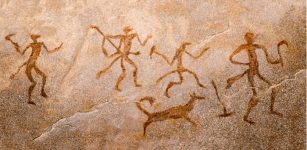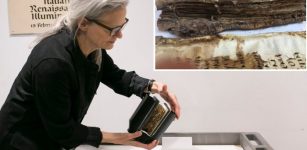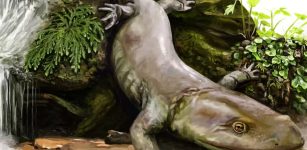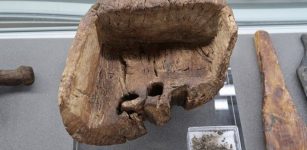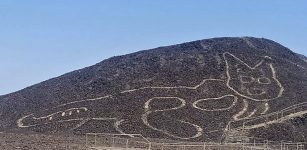Has The Viking Ship Burial Of King Bjørn Farmann Been Found At Jarlsberg Manor, Norway?
Jan Bartek - AncientPages.com - There is no doubt. Archaeologists are convinced "something" of historical importance is buried in the fields in south-eastern Norway, but what is it?
Recent archaeological excavations at Jarlsberg Manor in southeastern Norway have yielded significant findings suggesting a Viking ship burial. The investigation began in 2018 when metal detector surveys uncovered rivets in a field at the site. Subsequent ground-penetrating radar surveys confirmed the existence of a former burial mound in the area.
Credit: Adobe Stock - ChaoticMind
This summer, a two-week excavation was conducted to uncover more details about the buried artifacts. While initial findings were promising, Christian Løchsen Rødsrud, the excavation leader, maintained a cautious approach in his statements to the Norwegian Broadcasting Corporation NRK. He confirmed evidence points to a boat or a ship at the site.
After reviewing the material unearthed, however, he is confident:
“We’ve found a place for a ship burial,” says the archaeologist.
Despite the ship being plowed into pieces and its rivets scattered, Rødsrud expresses satisfaction:
“We can now say for certain that yes, here lie the remains of a Viking ship. This discovery adds a new landmark to the map, once a significant site during the Viking Age,” he told Science in Norway.
It is the rivets that reveal what kind of ship it is.
“The size of the rivets indicates that it was a large ship. Their similarity to those found at Gokstad and Oseberg leaves no doubt,” says Rødsrud.
The burial mound here at Jarlsberg Manor has long been erased by agricultural activities, along with the ship that once lay there. However, recent excavations this summer have conclusively confirmed the presence of a Viking ship at this site. Credit: Museum of Cultural History / University of Oslo
The result of two weeks of digging was around 70 rivets. The dimensions suggest they were used to hold together thick planks up to 2.5 centimeters thick.
“Then we’re talking about Viking ship size,” says Rødsrud, who was also the excavation leader when the Gjellestad Ship was excavated a few years ago – the first excavation of a Viking Ship in Norway in 100 years.
Upon closer examination, researchers discovered that two objects initially thought to be rivets were horse crampons. These spikes are designed to be attached to horse hooves for traction in icy conditions.
The archaeologist provides further context, explaining that metal detection surveys at the site yield continuous signals. This is due to hundreds, potentially thousands, of rivets scattered throughout the ground. These rivets are believed to be the remnants of a Viking ship that was plowed through over a millennium ago.
This abundance of metal artifacts presents both challenges and opportunities for archaeologists. The widespread distribution of rivets indicates the ship's location and provides valuable information about its size and construction. However, the sheer quantity of metal objects can make it difficult to distinguish between different types of artifacts without careful examination.
Christian Løchsen Rødsrud is excavating for traces of a Viking ship at Jarlsberg Manor outside Tønsberg in southeastern Norway. Credit: Museum of Cultural History / University of Oslo
"It’s interesting, as we’re now into grave goods. The ship and the horse are recurring themes in Viking Age burial customs and mythology, and are a typical phenomena one would expect in a ship burial. Finding horse crampons in the material suggests that the rest of the grave goods are also in the field.
Each year the plow passes over the field, it further damages the burial mounds and what little remains of the mound’s base. The objects in the plow layer take a beating from the plow every year. It would’ve been exciting to find out more about the person buried here,” Rødsrud says.
The Grave Of A Viking King?
Archaeological evidence suggests that this site may have been the final resting place of Viking king Bjørn Farmann, a son of Harald Fairhair. Historical accounts, specifically Snorri's sagas, indicate that Bjørn Farmann met his demise at the Sæheimr estate, allegedly at the hands of his brother, Eric Bloodaxe.
It's worth noting that approximately a century ago, between 1917 and 1918, archaeologists excavated another burial mound near this site. This particular mound was known as the Farmann mound, potentially establishing a connection to the aforementioned Viking king.
The large rivets, securing thick planks, leave archaeologists entirely confident that a Viking ship was once buried at Jarlsberg Manor. Credit: Museum of Cultural History / University of Oslo
“The old archaeologist A.W. Brøgger was completely convinced that he would find a ship here,” says Rødsrud.
"This was during the aftermath of the Gokstad and Oseberg discoveries, so the memory of uncovering a Viking ship was still fresh."
But Brøgger only found some spades and a stretcher.
"It would take another hundred years for solid evidence to emerge that a ship burial was not entirely far-fetched. He was simply searching the wrong mound," Rødsrud says.
The recent excavation at Jarlsberg has yielded significant insights into its importance during the Viking Age, as reported by Rødsrud. The site is located in a culturally rich landscape despite the ship's remains having been damaged by agricultural activities. The surrounding forested hills near Jarlsberg Manor contain various boat graves of different sizes.
See also: More Archaeology News
Evidence suggests that these burial sites may encircle a central area of importance. Rødsrud notes that this landscape, with its multiple ship burial locations, is still relatively unexplored and warrants additional investigation and study. The findings highlight the potential for further archaeological discoveries and a deeper understanding of Viking Age practices in this region.
Written by Jan Bartek - AncientPages.com Staff Writer






